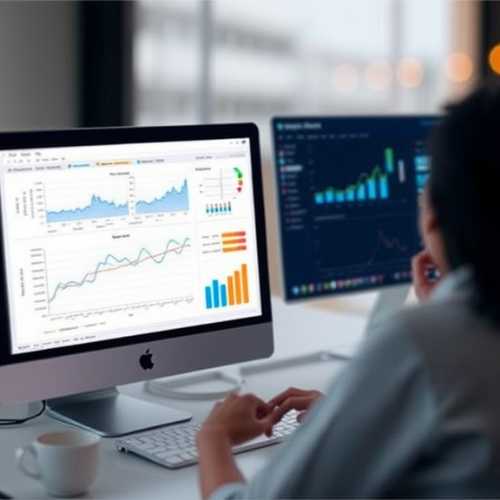Introduction
There may be data likened to the new oil, but without a visualization that is clear and compelling, it’s just a bunch of statistics. Designing reports can present significant improvements in visual appeal while making them highly functional for data analysis specialists, business intelligence analysts, students, or any individual involved with data.
Power BI, the number one market leader in business intelligence tools, provides unlimited possibilities for the transformation of raw data into actionable insights. It does not just produce great reports by itself — it comes from creating them extremely meticulously.
This blog will walk you through 10 great tricks of expert professionals to build extremely interactive and awesome Power BI reports that not only inform but also impress. These recommendations are designed to make it better to level up your dashboard and collaborate more effectively with data whether you are a newbie to Power BI or just upskilling.

1. Understand Your Audience and Decision Makers
Before you even start designing your report, ask yourself this critical question: Who is this report for?
Knowing your audience, whether they’re executives, team leads, or technical analysts, will shape every decision you make. Executives, for example, often prefer high-level summaries and visual storytelling, while analysts may need drill-down capabilities and access to detailed data.
Tips:
1. Meet with key stakeholders to align priorities and objectives.
2. Tailor the content and visualizations to their preferences — an interactive slicer for analysts or a KPI dashboard for executives.
3. Avoid technical jargon if your audience is less data-savvy.
4. Understanding who your audience is ensures that your reports are meaningful and actionable.

2. Keep Your Reports Clean
Less is more when it comes to report design. Overloading your dashboard with too many visuals, colors, or charts can overwhelm the viewer. Aim for simplicity and elegance.
Tips:
1. Remove unnecessary visuals or filters. Focus on what matters most.
2. Use consistent spacing, alignment, and padding to give your report a polished look.
3. Stick to a coherent theme — Power BI allows custom themes for a unified design.
4. A clutter-free report ensures that your message is communicated clearly and instantly.

3. Spotlight Top Metrics
Grab attention where it matters most. Highlighting key performance indicators (KPIs) and summaries at the top of your report ensures users can see the most critical information at first glance.
Tips:
1. Use card visuals or summary tiles to showcase important metrics like revenue, growth percentage, or customer retention rate.
2. Apply bold fonts or contrasting colors to make these metrics stand out.
3. Align summary visuals horizontally for a professional layout.
4. Power BI’s customizable fonts and themes make it easy to spotlight your top metrics effectively.

4. Take Advantage of Tooltips
Think of Tooltips as a hidden goldmine. They allow you to add detailed insights without overcrowding your report. Users can hover over a visual to access additional context, comparisons, or calculations.
Tips:
1. Add Tooltips to visualizations like bar charts or maps for quick insights.
2. Use Tooltips to display year-over-year growth, percentage breakdowns, or supporting data.
3. This simple feature makes your Power BI reports more informative without compromising cleanliness.
5. Use the Right Visualization for Your Data
Your choice of chart or graph says a lot about the story you’re trying to tell. Picking the wrong one can confuse or mislead your audience.
Quick Guide to Visualization Types:
Bar Chart: Comparing discrete categories, like sales by region.
Line Chart: Showing trends over time.
Pie Chart: Simple composition breakdowns (but don’t overuse them!).
Scatter Plot: Visualizing relationships or correlations.
Heatmap: Highlighting density or intensity in a dataset.
Customize these visualizations with Power BI’s rich formatting options to make your data storytelling crystal clear.

6. Use Slicers for Interactivity
Interactive elements like slicers make your reports more dynamic and engaging. They empower users to filter data instantly and personalize their view.
Tips:
1. Experiment with different slicer types (text, date ranges, or numeric ranges).
2. Place slicers strategically to avoid clutter.
3. Use slicers during live presentations to quickly answer audience questions.
4. By incorporating slicers, you turn static reports into interactive dashboards.

7. Make Your Report Accessible & Inclusive
Everyone deserves to benefit from your data, regardless of their abilities. Prioritizing accessible design makes your Power BI reports more inclusive and user-friendly.
Tips:
1. Test your dashboards with Power BI’s built-in Accessibility Checker.
2. Choose colorblind-friendly palettes, avoiding excessively bright or clashing colors.
3. Use descriptive labels for visuals and include alt text for images.
4. Inclusive reports not only serve a wider audience but also reflect well on your organization’s values.
8. Annotate Trends with Conditional Formatting
Conditional formatting in Power BI is a fantastic tool for highlighting insights and calling attention to trends, patterns, or anomalies.
Examples:
1. Use heatmaps to identify performance hotspots.
2. Add color-coded bars to reflect threshold-based results.
3. Highlight outliers with bold colors or icons.
4. Conditional formatting helps direct your audience’s focus to the most critical areas of your report at a glance.

9. Combine Power BI and Power Apps
Take your reports to the next level by integrating them with Power Apps. This dynamic duo allows you to collect and update data in real time, feeding back into your reports.
Practical Use Cases:
1. Use Power Apps for instant survey feedback on business performance.
2. Enable real-time data entry, like inventory updates, using Power Apps forms.
3. Add action buttons so users can update records directly from your report.
4. This seamless integration enhances both the functionality and interactivity of your reports.

10. Experiment and Innovate
Last but not least, don’t be afraid to get creative with your Power BI reports. Test new layouts, try custom visuals, and explore advanced features to keep your reports fresh and engaging.
Tips:
1. Use the Power BI marketplace to find add-ons that suit your needs.
2. Create custom visuals or experiment with AI-powered visuals for deeper insights.
3. Stay up-to-date with Power BI updates to access the latest features.
4. Continuous innovation not only enhances your reports but also keeps your skills sharp.
Make Your Reports Work Harder for You
With these 10 expert tips, you’re ready to transform your Power BI reports into stunning, insightful dashboards. From understanding your audiene to leveraging accessibility features, these strategies will help you design reports that are visually engaging, highly interactive, and packed with actionable insights.
Start applying these techniques today, and watch how your reports captivate audiences and empower better decision-making. Want more tips and tricks? Join NIPSTec courses for practical hands-on experience and personal guidance.
Happy reporting!